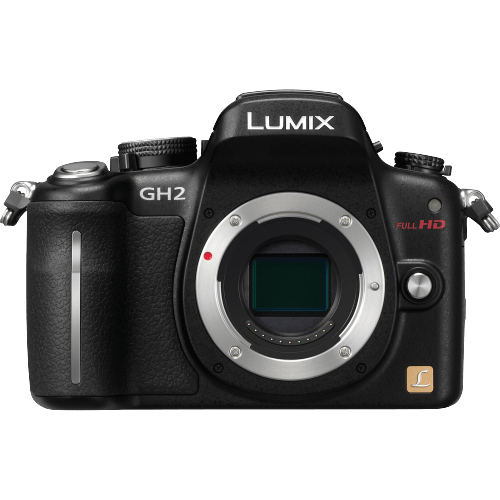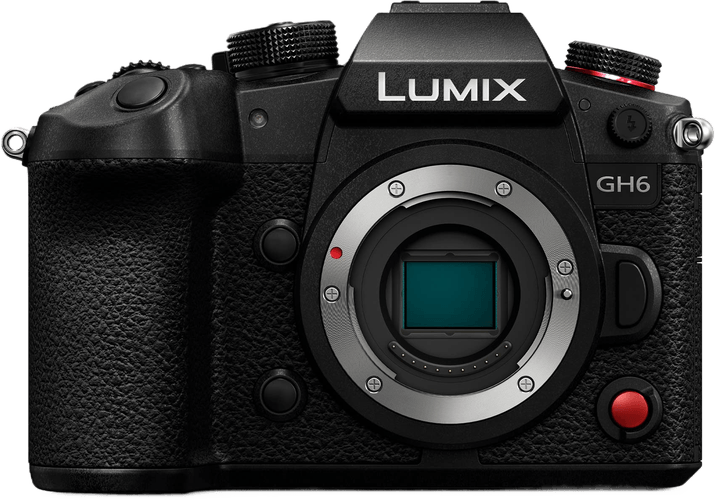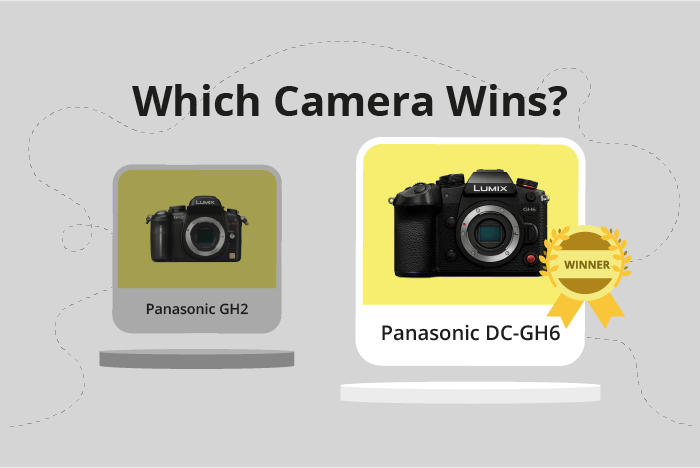Panasonic Lumix DMC GH2 vs Lumix DC-GH6 Comparison
Panasonic Lumix DMC GH2

Panasonic Lumix DC-GH6

The Panasonic Lumix DC-GH6 outperforms the Panasonic Lumix DMC GH2 with a score of 73/100 compared to the GH2’s score of 47/100. Both cameras share similarities, such as being mirrorless and having a similar size and shape. However, the GH6 excels in various aspects that make it a superior camera.
The GH6, released in 2022, benefits from more advanced technology and features, which justify its higher launch price of $2199 compared to the GH2’s launch price of $1100 in 2010. The improved specifications contribute to the GH6’s higher score.
On the other hand, the GH2 is lighter, weighing only 0.97lbs compared to the GH6’s 1.81lbs, which could be an advantage for those prioritizing portability. Despite this, the overall performance and capabilities of the GH6 make it a clear winner between the two cameras.
Panasonic Lumix DMC GH2 vs Lumix DC-GH6 Overview and Optics
The Panasonic Lumix DC-GH6 emerges as the winner in the optics comparison, scoring 69 out of 100, while the Panasonic Lumix DMC GH2 scores 48. Both cameras share several common specifications, including a CMOS sensor, Micro Four Thirds sensor size, Micro 4/3 lens mount, and image stabilization.
The GH6 outperforms the GH2 in several aspects. It has a higher megapixel count at 25 compared to the GH2’s 16.05, resulting in better image resolution. The GH6 also boasts a faster shooting speed of 14 frames per second, as opposed to the GH2’s 3 frames per second. This makes the GH6 more suitable for capturing fast-moving subjects and action sequences. Additionally, the GH6’s sensor has a higher DXOMARK score of 71, compared to the GH2’s 60, indicating improved overall image quality.
On the other hand, the GH2 has the Venus Engine FHD processor, whereas the GH6 uses the Venus Engine processor. While both processors are efficient, the Venus Engine FHD in the GH2 may provide slightly better image processing capabilities.
Taking all these factors into account, it is evident that the Panasonic Lumix DC-GH6 is superior in terms of optics, offering higher resolution, faster shooting speed, and better overall image quality. Although the GH2 has a slightly different processor, it does not compensate for the significant advantages the GH6 holds in other areas. Thus, for those seeking better optical performance, the Panasonic Lumix DC-GH6 is the clear choice.
Panasonic Lumix DMC GH2 vs Lumix DC-GH6 Video Performance
The Panasonic Lumix DC-GH6 outperforms the Panasonic Lumix DMC GH2 in video capabilities with a score of 96/100 compared to the GH2’s 56/100. Both cameras share some common features, including the ability to record video and adjust settings manually. However, the GH6 surpasses the GH2 in several key aspects.
The GH6 boasts a maximum video resolution of 6K (5760 x 2880) and a maximum frame rate of 120fps, providing higher quality video and smoother motion capture than the GH2, which is limited to Full HD (1920 x 1080) and 60fps. This difference makes the GH6 more suitable for professional videography and capturing fast-moving subjects.
Another advantage of the GH6 is its built-in time-lapse functionality. This feature allows users to create stunning time-lapse videos without the need for external software or equipment, a convenience not available in the GH2.
The GH2, however, does have some benefits. Its lower video resolution and frame rate may be sufficient for casual users who do not require advanced video capabilities, and its lower price point may be more attractive to those on a budget.
Taking these factors into account, the Panasonic Lumix DC-GH6 is the clear winner for videography, offering superior video quality, frame rate, and additional features like time-lapse functionality. The Panasonic Lumix DMC GH2, while lacking in comparison, may still be suitable for those with basic video needs and budget constraints.
Panasonic Lumix DMC GH2 vs Lumix DC-GH6 Features and Benefits
The Panasonic Lumix DC-GH6 outperforms the Panasonic Lumix DMC GH2 with a feature score of 83/100, compared to the GH2’s score of 49/100. Both cameras have a 3-inch touchscreen and a flip screen, but they differ in several other features.
The GH6 boasts a higher screen resolution of 1,240,000 dots, making it superior to the GH2’s screen resolution of 460,000 dots. This results in a crisper and clearer display for the GH6, enhancing the user experience. Additionally, the GH6 is equipped with both Wi-Fi and Bluetooth capabilities, which the GH2 lacks. These connectivity options make it easier for users to transfer and share photos, as well as control the camera remotely.
Although the GH2 falls short in these areas, it still shares some useful features with the GH6, such as the touchscreen and flip screen. These features are beneficial for users who want to shoot from different angles and have better control over their camera settings. However, the GH2’s lower feature score indicates that it is not as advanced as the GH6.
Considering the significant difference in feature scores and the additional capabilities of the GH6, it is evident that the Panasonic Lumix DC-GH6 is the superior camera. The GH6’s higher screen resolution and connectivity options make it a more versatile and user-friendly choice for photographers. On the other hand, the GH2 may be a suitable option for those who prioritize simplicity and do not require advanced features. Ultimately, the Panasonic Lumix DC-GH6 is the clear winner in this comparison.
Panasonic Lumix DMC GH2 vs Lumix DC-GH6 Storage and Battery
The Panasonic Lumix DC-GH6 outperforms the Panasonic Lumix DMC GH2 in storage and battery, with a score of 68 to 21. Both cameras accept SD cards, but the GH6 also supports UHS-II SD cards and CFexpress B cards. Additionally, the GH6 has two memory card slots, compared to the GH2’s single slot.
The GH6 has a longer battery life of 360 shots, while the GH2 offers 330 shots. The GH6 uses a Li-ion Battery Pack, whereas the GH2 uses a DMW-BLC12PP battery. Moreover, the GH6 supports USB charging, which the GH2 lacks.
The GH2 does not have any advantages over the GH6 in terms of storage and battery. The GH6’s superior storage options, battery life, and USB charging make it a better choice for photographers who require more flexibility and convenience in these areas.
Panasonic Lumix DMC GH2 vs Lumix DC-GH6 – Our Verdict
Are you still undecided about which camera is right for you? Have a look at these popular comparisons that feature the Panasonic Lumix DMC GH2 or the Panasonic Lumix DC-GH6:

